

Across Australia by Train
Pioneers of an Unparalleled Wilderness
RAILWAYS OF THE COMMONWEALTH -

MODERN TRANSPORT METHODS are a feature of the Australian railways. This picture shows a Rail Motor on the New South Wales system.
THE modern traveller arriving in Australia finds trains as distinctive in the railway world as the kangaroo is in the animal world, for the island continent is the land that is different from other countries.
There are trains which, like the camel, have to carry a hump of extra water to cross a wilderness unparalleled in both hemispheres; “poison” trains to kill weeds that would choke the track if not dealt with promptly; sheep trains which are double-
There are railroads which have been held up because all the navvies have dashed off to search for gold; railroads built specially to enable men to hurry to the goldfields; railroads which handle rush-
There is the 3,384-
In considering Australian railroads it is important to remember that in the middle of the last century the continent was isolated. Australia has now been reached in a week-
But Australia was determined to have railways, and the experience of the Melbourne and Hobson’s Bay Railway Company, is a typical example of her determination. The company ordered locomotives, carriages and wagons from England. The carriages and wagons arrived, but the four locomotives did not. This was a set-
 THE RAILWAY LINK from Fremantle, on the western side of Australia, to Brisbane, the capital of Queensland.
THE RAILWAY LINK from Fremantle, on the western side of Australia, to Brisbane, the capital of Queensland.
Thus on September 12, 1854, the first railway in Victoria and the first locomotive-
On the opening run the engine achieved a speed of fifteen miles an hour, but bad fuel on September 16 and damage to the locomotive on September 18 hampered the running, and for a while trains were discontinued. But the directors, not wanting the line to be idle while the engine was being repaired, remembered the existence of a pile-
On December 2, 1854, however, the directors had to admit defeat and published the following advertisement: “The Loco-
It was unfortunate for the first railways that gold fever broke out as the lines were being laid. Workers left for the gold fields and costs soared like rockets. The little line between Sydney and Parramatta, fourteen miles long, took years to build and cost £50,000 a mile. At one time 500 navvies imported by the company deserted. In Adelaide labourers demanded one pound a day, a driver with a horse and cart demanded twelve pounds a week.
The Quest for Gold
Gold had been discovered earlier, but it had been kept a secret. In 1839 a Polish Count, Paul Strzelecki, on a scientific exploring expedition from Sydney across the mountains into the region of Victoria which he called Gippsland, observed particles of gold among decomposed iron-
In 1823 a surveyor had picked up some specks of the precious metal. Years later a Sydney geologist, W. B Clarke, made observations in the Bathurst region and showed a specimen to Governor Gipps. Gipps, dreading the unrest which the news would cause among the convicts, said to the geologist: “Put it away, Mr. Clarke, or we shall all have our throats cut.” For this reason the Governor asked Count Strzelecki to say nothing and the Count complied, omitting the subject in his first book on Australia. In 1848, a piece of gold found near Berrima was shown to the officials in Sydney, but they would not order a survey.
In many places, however, men were finding gold and the secret could not be kept. A shepherd found gold at the roots of a tree which had been blown down; a labourer digging a hole for a fencing post struck a nugget with his spade and sold it for a hundred pounds: these men talked.
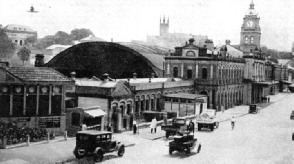
BRISBANE CENTRAL STATION. From this terminus in the capital of Queensland, lines radiate in all directions. There are over 6,400 miles of railway track in Queensland, most of the lines having a gauge of 3 ft 8-
Edward Hargreaves, who had been a sheep farmer on the Bathurst Plains, went to the Californian goldfields; he saw the similarity in the formation of the rocks and hurried back to Australia. In vain did the Lands Commissioner at Bathurst write to Sydney in 1851 complaining that Hargreaves was employing men to dig for gold. Hargreaves had already written to Governor Fitzroy, saying that he could point out where gold was to be found if he were rewarded; eventually he was given £10,000.
Directly the news came to Melbourne the gold rush began. Month by month fresh strikes were made and Ballarat and Bendigo were tapped; before the end of the year gold worth nearly £900,000 had been found in Victoria. From every country men poured into Australia, and if a man like Lord Robert Cecil, afterwards Marquis of Salisbury, Prime Minister of Great Britain, joined in the rush it is not to be wondered at that the labourers imported to construct the railways did like-
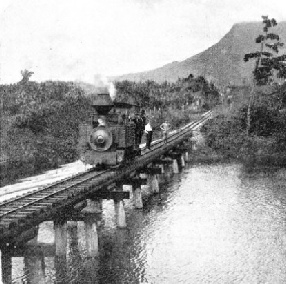
A SPECIAL LOCOMOTIVE used for sugar-
The Sydney Railway Company began work on a line to Parramatta on July 3, 1850, but the gold rush intervened, and it was not until September 26, 1855, that the railway was opened for traffic.
This meant that it had taken more than five years to build fourteen miles. In Melbourne the first locomotive had made its run on a two-
In those days the citizens of Adelaide had to pay £3 a ton for freight cartage by bullock wagon for those seven miles. The railway cut the rate down to 4s 6d a ton.
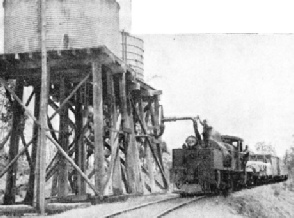 REPLENISHING THE TANK of a Garratt locomotive attached to a freight train at Brookdale, in the southwest timber district of Western Australia. Jarrah, the timber, is famous for its resistance to decay and insects, and is used for railway sleepers and for building.
REPLENISHING THE TANK of a Garratt locomotive attached to a freight train at Brookdale, in the southwest timber district of Western Australia. Jarrah, the timber, is famous for its resistance to decay and insects, and is used for railway sleepers and for building.
Before the State Railway was opened the people of Adelaide had to walk to Port Adelaide, unless they could pay for a ride in a bullock dray or for a lift in an English gig that bumped over the road; they were so impatient that in 1854, before the locomotives arrived, a railway was already in operation between Goolwa and Port Elliot, but the “locomotives” were horses.
Fares on the State Railway between Adelaide and Port Adelaide were 2s 6d first-
But whereas the tracks in Melbourne and Adelaide were of 5 ft 3-
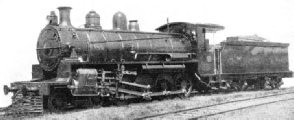
FOR GOODS TRAFFIC on the Queensland Government Railways. This locomotive has a 4-
This matter must be approached with caution. Australians are very sensitive about it. In 1846, Mr. Gladstone, while Colonial Secretary, recommended the 4 ft 8½-
Later on. New South Wales appointed yet a third engineer, who advised that the twenty miles of track laid when he took over the job should be torn up and replaced by broad gauge, but the Government dismissed the possibility of their lines ever meeting those of the Victorian railways as a “very remote contingency”, and the suggestion was rejected.
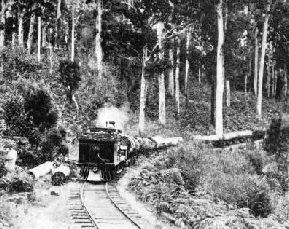
A LOG TRAIN on a private timber line at Manjimup in Western Australia.
It is easy in these days to get heated about the muddle, but it is more just to visualize the conditions at the time. Nearly a score of years were fated to pass before the deep-
That is why, to-
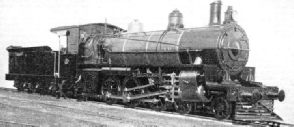 THIS 4-
THIS 4-
It is most unlikely that the muddle will ever be straightened out, for the reason that it would cost too much. Attempts have been made, but it is doubtful if they will succeed. Any reader who approaches the subject of Australian railways with the idea that he will be able to step off a liner at Fremantle, Western Australia, board a train, and step off at Brisbane, Queensland, must remember the foregoing, and be under no illusions: Australia is different, even to the gauges, more than either Europe or America.
The Trans-
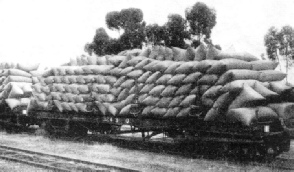
GRAIN TRANSPORT forms one of the most important items in the revenue of the Australian railways. This illustration shows how trucks are loaded with bags of wheat in Western Australia.
The Sydney Railway Company made Mr. Connell, locomotive superintendent of the London and North Western Railway, their Consulting Engineer, and it was he who took charge in England of the construction and transport of the equipment.
The first engines, of which there were four, were modelled closely on some 0-
For years the Australian railways imported their locomotives from Great Britain and the United States until their own work-
Except for one railway -
Another railway in Western Australia is concerned entirely with timber. It is owned by Millars’ Timber and Trading Company, of Perth, and consists of 239 miles of 3 ft 6-
£5,000 a Mile
The railway taps the Jarrah forests, and the timber is famous all the world over for its resistance to decay and insects. The trees provided the sleepers for the Trans-
The gauge of 3 ft 6-
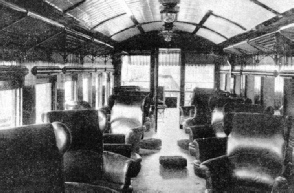
IN QUEENSLAND these attractively furnished parlour cars are attached to long-
The discovery of gold in Western Australia encouraged the growth of railways. The boom began in the ‘nineties, when two men made a rich strike at Coolgardie. The towns of Coolgardie and Kalgoorlie sprang up in what had been the desert, and the railway followed the prospectors.
In this State the track laid until 1879 was only thirty-
The Central Australia Railway, owned by the Commonwealth Government Railways, connects Port Augusta, South Australia, with Alice Springs, in the heart of the continent, by a track 771 miles long. The track crept up by degrees from Oodnadatta. and when, in August, 1929, the first passenger train arrived, the entire population of Alice Springs, numbering about 200, turned out to welcome it. The parlour coach and the dining-
In considering the subject of Australian railways it must be remembered that the great bulk of the people of Australia live near the south-
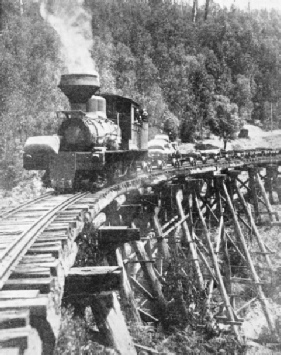
“PUFFING BILLY” is the nickname of this timber-
By then four capitals, Brisbane, Sydney, Melbourne, and Adelaide were linked by rail, but Western Australia was cut off by the desert and not until 1917 did the transcontinental railway connect Perth with the other capitals. Indeed, the desert rendered Western Australia an island: the only communication was by sea. The two dead ends at Kalgoorlie, Western Australia, and at Port Augusta, South Australia, were linked by a single track 4 ft 8½-
Owing to the difference in gauges at various places, it is not possible to travel all the way in the same train.
The linking of Kalgoorlie with Port Augusta by the Trans-
The country through which the railway now runs falls into four divisions: (1) The granitic plateau, extending for 167 miles eastward from Kalgoorlie; (2) The limestone or Nullarbor Plain, which runs for 450 miles to the east from the edge of the granitic country; (3) The belt of sand hills on the eastern edge of the limestone region, through which the line runs for about fifty miles; (4) The stretch of country extending for nearly 400 miles from the eastern edge of the sand hills to Port Augusta.
There was not a single running stream in the whole of the distance and probably not a drop of drinkable surface water for about 800 miles of it, while the supplies of water on the remaining 250 miles were almost negligible. For 800 miles there was no settlement of any kind.
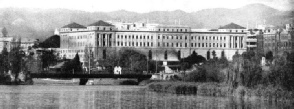
ADELAIDE STATION, the headquarters of the South Australian Government Railways. £350,000 was recently spent on it, and this railway station is now one of the finest in the British Empire.
Thus the preliminary survey was a tremendous task. The Commonwealth sanctioned £20,000 for the work, and in 1908 survey parties set out from both Kalgoorlie and Port Augusta, the other from Kalgoorlie on July 1, and the one from Port Augusta in June, equipped with camels to carry food, water and gear. The Kalgoorlie party had ninety-
The chief engineer of the Kalgooriie party went ahead of the main party; to the rear camel of the pack-
130 Degrees in the Shade
Construction began at the Port Augusta base on September 14, 1912, and at Kalgoorlie on Feb 12, 1913. The line was scheduled to be finished in 1915, but the Great War intervened and added to the difficulties. Despite this, the rails were linked at the boundary on October 17, 1917. The first through train left Port Augusta with an official party on October 22, 1917. The feat was obscured by the war, otherwise it would have held the attention of the whole world. The gauge is 4 ft 8½-
It was more like a campaign than plate-
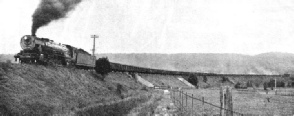
HAULING A TEST LOAD of 2,000 tons. A “D57” type goods locomotive in New South Wales hauling a giant freight train, which can be seen curving away into the distance.
After twenty-
As the rails reached out into no-
The summer when the section of fifty miles in the sand hills was tackled proved unusually hot, and the heat of the sand hills was terrible. On one occasion a temperature of 130 degrees in the shade was recorded. The engineer-
The navvies were paid thirteen shillings a day. No alcoholic liquor was allowed. The Government charged twenty-
The organizing genius of the whole achievement was Colonel Norris G. Bell, engineer-
Cold facts and figures cannot convey the achievement of the Australians. No mere measurements and particulars can bring home the perseverance of the men who built that railway. They worked in intense heat that split their nails, pestered by hosts of flies and blood-
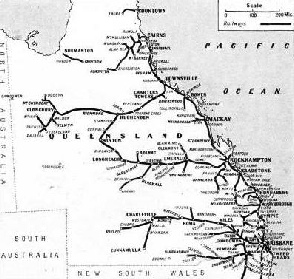
THE RAILWAYS OF QUEENSLAND. This map shows the chief routes in north-
The men who built the trans-
When the day’s work was over the toilers had respite. As they progressed they were supported by the welfare organization; their children were taught in schools, and news of the outside world was brought to them.
The great feature of the railway is the Nullarbor Plain; there is nothing like it anywhere in the world. Scientists say it was once under the sea, and the fact remains that when rain falls the water sinks through the limestone into subterranean reservoirs; when it is pumped up it is too salt for locomotives. Stock can drink it, but not engines. Nullarbor is derived from the Latin (nullhus arbor -
Only dingoes and rabbits live in the holes and caves. The Australian bustard, a bird weighing up to twenty-
To return to the water problem: at the Western end Kalgoorlie itself depends upon a pipeline to the Mandaring Weir, 350 miles away -
At a point approximately 210 miles from Port Augusta the engineers were fortunate, for they tapped usable water at a mere 60 ft, obtaining as much as 120,000 gallons in twenty-
A World Record
On a stretch of nearly 150 miles every bore put down produced only salt water, and in other instances, water suitable for stock but useless for locomotives. At two points salt water was condensed for the engines, and at one of these points fuel for the condensers was hauled several hundred miles,
The precious water was guarded in dams and cement tanks which had to be roofed. It was found at first that the dry air soon caused evaporation, but roofing prevented this.
When on October 17, 1917, the two tracklayers met and the line was completed a wonderful organization had grown up in the course of the work. There were hospitals, post-
Train speeds average twenty-
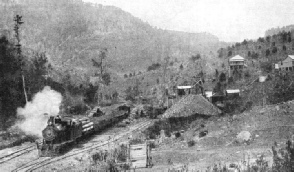
A COAL TRAIN at the Tannymorel coal mines on the Killarney branch of the main Queensland railway system.
The “Trans”, as the railway is affectionately called in Australia, has several distinctions. The Nullarbor Plain section is dead straight and almost dead level.
In addition, the Trans-
For the first 167 miles from Kalgoorlie the “Trans” passes through timbered country covered fairly thickly with the gum trees so typical of the Australian landscape; but directly the granite dips below the limestone the gum trees vanish with a suddenness so startling that a line could be drawn north and south across the track, to the west of which the gums dominate the scenery, while to the east there are none. From this spot there is not a single eucalyptus till the mallee gums of the Ooldea sandhills, 450 miles to the east, are reached.
Naretha, 205 miles from Kalgoorlie, lies to the east of a ridge with a fair growth of black oak, myall and mulga, and from this point the line runs over the Nullarbor Plain. Except for a narrow belt of black oak and myall crossing the line at 286 miles, there is not a tree, and only at long intervals a bush more than three or four feet high. Then begins the true Nullarbor Plain.
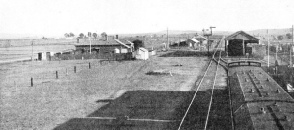
ALICE SPRINGS. The terminus of the Central Australian Railway, which line is controlled by the Commonwealth of Australia. The line runs almost to the heart of Australia, from Port Augusta, on the coast.
The Nullarbor is not quite dead level, but rolls away, mile after mile, in gentle undulations. A foot or so of red soil covers the limestone, but on all the rises fragments of broken limestone project upwards through the soil or lie loose upon the surface. Here and there are dongas or slight depressions in which a greater depth of soil collects; in spring these show a luxuriant growth of grass and vegetation. Most of these dongas are small, of a few acres, but some near the western end of the Nullarbor Plain contain hundreds of acres. Some of the dongas are covered with grass a foot long, waving in the wind, and dotted with pink and white daisies and other flowers. Dongas are rare in the great central area but reappear towards the eastern edge of the plain.
Characteristic plants of the plain are the bluebush, with its ghostly colouring; and the saltbush, best of all native fodder plants, with its greyish-
Grass, which comes in the spring, withers before the heat of summer, but the saltbush and the bluebush are perennial. These bushes are the great feature of the plain. Their leaves absorb the moisture from every chance shower, and when there is no rain they absorb the dew, and so survive when the grass withers. Here and there a tiny dwarf acacia raises spine-
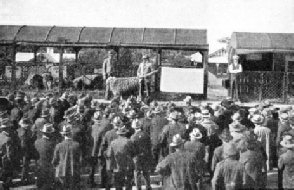
FARMING LESSONS FROM THE TRAIN. The official demonstration train which visits outlying districts and gives instruction to farmers
There is a great fascination about the Nullarbor. The single track of the railway stretches ahead and behind without a curve, the shining rails running on into infinity, seeming to meet in the distance. There is nothing but plain and sky.
The Nullarbor to the north of the line is unexplored country, although it has been conjectured that the plain has a total area of nearly 100,000 square miles.
Beneath the limestone of the Nullarbor are caverns and passages. Blowholes are numberless, many blind and shallow, others leading to the strange underworld. The blowholes are the lurking places of centipedes, spiders and beetles, while cave-
The line runs across the border into South Australia, 452 miles east of Kalgoorlie, where a stone cairn marks the boundary: the great plain stretches for another 150 miles, until the Musgrave Ranges come into view to the northeast. Then a long “edge” runs north and south across the plain.
Annual Rainfall -
The line dips about eighty feet, and the character of the country begins to change. Real trees appear, only ten or twelve feet high, though compared with the bushes of the plain they are giants. Grass grows in the hollows. A few miles more and this country shades off into the sandhills. The Nullarbor Plain is left behind.
At Ooldea, 624 miles from Kalgoorlie, the sandhill belt begins. It is a tangle of ridges and hollows of a fine dust which looks like sand. The ridges and hollows are covered by small trees, but when the surface is cleared the soil is easily moved by the wind.
The last division of the line, from the sandhills to Port Augusta, is more varied than any of the others. For about a hundred miles, until the hilly country round Tarcoola is reached, the line runs across red-
Fifty miles farther is the first fence the line has crossed since leaving Kalgoorlie, the outer boundary of the Wilgena run, which is eighty miles long and forty miles wide. On a corner of it is the Tarcoola goldfield, where the rocks come to the surface and form low, rugged hills. The hills die away again as the “Trans” reaches the “Lake Country”.

THE MAIL TRAIN FROM SYDNEY. This train proceeds from the capital of New South Wales to Brisbane, the capital of Queensland, a journey of 613 miles, by way of Newcastle, Gloucester and Grafton.
The lakes are vast, shallow pans, some of them hundreds of miles square, covered with a shallow sheet of water after rains, and becoming mere beds of salt in the dry season. But the shallow water is as blue as the sea. and the lakes are picturesque enough with their waters reflecting the sun, and surrounded by bluffs, and mimic cliffs, with wooded slopes beyond. The line crosses a corner of Lake Hart, and later it skirts the shores of the Island Lagoon, which has a remarkable hill, peaked like a miniature volcano, standing in the middle of it. The line crosses Lake Windabout, beyond which is Pernatty Lagoon, the waters of which are impregnated with copper.
After fifty miles or more of plain country, with strange flat-
No part of the long stretch of country has an average rainfall of more than 10-
The regular passenger service is two trains a week each way, but many special passenger trains are run. Out of the total coaching stock half are sleeping cars, and it is unlikely that any other railway in the world could show such a high per-
The length of the “Trans” express depends upon the number of bookings. There are usually seven corridor coaches, including dining-
The electric staff system of working is in operation throughout, and each station is also a telegraph depot. Every gang of workmen not located near a telegraph station, and every train are equipped with portable telephones and appliances for making connexion with the electric staff wire at any point. The staff sections are widely spaced, and the portable telephone is therefore an important precaution in the event of a break-
News is telegraphed to points along the route and made available to passengers.
Change of Locomotives
Two splendidly appointed special cars are available. Car No. 1 is a self-
The change of engines in the run from Port Augusta is made at Cook, 513 miles from Port Augusta and 538 miles from Kalgoorlie. The locomotives are of the 4-
Loads up to 470 tons, however, have been worked across the Nullarbor Plain -
In every part of the line the prices of the goods and food are the same. The supply train is not only a retail shop, but is also the great event in the routine of the workers in the wilderness. Supplies of bread are sent twice a week, and a butcher on the train kills sheep while the van is travelling, and so times his work that by the time the train arrives at each station the meat is ready for sale. There is a dispensary van, and the whole organization is a credit to the Commonwealth Government Railways, who have spent nearly £8,000,000 to connect the Western State Capital with her sisters. The time saved between Melbourne and Perth is about three days, as compared with sea transport.
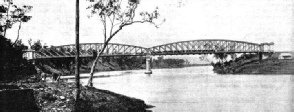
A GRACEFUL DOUBLE-
It must not be thought that the title, Trans-
After having booked in advance we board the train at Perth, bound for Brisbane. (The fare from Fremantle, the port for Perth, which is twelve miles away, is the same.) We have paid £23 14s 6d for our first-
Therefore the reader will understand why Australians are apt to make strong comments on the subject of gauges.
Now that we are in Brisbane we can see how varied are the problems that confront the Australian railroad engineer. The builders of the track across the Nullarbor Plain did not have enough water, the Queensland engineers have too much of it. Innisfail has an annual rainfall of 150-
From the beginning of the first railway Queensland pursued an active policy of decentralization, and lateral lines were built long before any coastal railway was undertaken. The three main systems, southern, central and northern tap all the pastoral lands of the State.
The Queenslander is the most light-
Mr. Abram Fitzgibbon, C.E., recommended a gauge of 3 ft 6-
Jungle Clearing
When their neighbours in New South Wales (gauge 4 ft 8½-
“We have never heard of New South Wales desiring to send us any goods which could not be carried by Queensland”, Queensland declares. There are heavy ranges with sharp curves on the Queensland side of the border. The most difficult item for the Queensland railways to carry was a German tank, which had been captured by Australian troops in France.
The difference in gauges formerly necessitated transhipment of passengers and goods at border stations, but this difficulty has been overcome by the construction of a 4 ft 8½-
Queensland has the largest railway mileage of all the Australian systems. The main line to the north is more than 1,200 miles long, and there are lines running into the interior nearly 600 miles long. No other State in the Commonwealth has so many dead-
It is during the rainy season in the mountains that the engineers have to be on the alert. After a storm an engineer on such a line may find that a bridge has been swept away by the tremendous volume of flood water; a torrent has taken the track in its stride, a landslide has left a stretch of line in the air, or huge trees have crashed upon the track. It is then that the vehicles fitted as breakdown wagons and the travelling crane come into use. There are wagons fitted with appliances to spray poison on the track, for not only does the railway engineer have to battle with storm, he must also keep the way through the jungle clear. Trains on some lines are so infrequent that the jungle is swift to close impenetrably upon the track. These lines depend upon seasonal traffic, and may be idle for a long period.
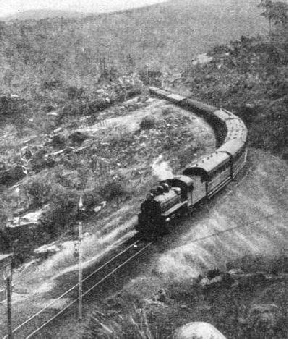
THE KALGOORLIE-
The railway looks after its passengers’ needs, and the charge for meals is very reasonable. At the Brisbane central station the charge for breakfast is 2s. (It should be explained that Britons in the tropics call breakfast a meal eaten between 11am and 2pm.) A three-
Passengers may obtain on application to the station-
South of Queensland the two great States of New South Wales and Victoria have developed one of the finest railway systems in the Southern Hemisphere.
You can read more on
and
and
On this website.
You can read more on the
in Wonders of World Engineering